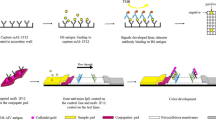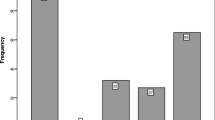Abstract
An immunocomb-based dot-ELISA, employing specially designed apparatus, was used to measure the antibody status for the three major poultry diseases – Newcastle disease, infectious bursal disease and infectious bronchitis – in single test sera. Positive samples could be classified into strong, moderate and weak positives by comparison with the colour reaction given by known strong and weak positive serum controls. The simultaneous dot-immunobinding assay gave reproducible results and allowed considerable savings on the cost of reagents compared to liquid ELISA. The antigen-coated immunocomb can be stored under refrigeration and the test can be performed rapidly under field conditions by trained personnel.
Similar content being viewed by others
REFERENCES
Chand, P., Sadana, J.R, Batra, H.V. and Khanna, R.N., 1989. Comparison of dot enzyme-linked immunosorbent assay (dot-ELISA) with other serological tests for the detection of Brucella antibody in bovine sera. Journal of Veterinary Medicine B, 36, 346-352
Hawkes, R., Naidey, E. and Gordon, J., 1982. A dot immunobinding assay for monoclonal and other antibodies. Analytical Biochemistry, 119, 142
Maiti, N.K., Saini, S, Singh, R, Oberoi, M.S. and Sharma, S.N., 1993. An improved dot ELISA to detect fowl adenovirus type antigen. Comparative Immunology, Microbiology and Infectious Diseases, 16, 245-250.
Marquardt, W.W., Johnson. R.B., Odenwald, W.F. and Schlotthober. B.A., 1980. An indirect enzyme-linked immunosorbent assay (ELISA) for measuring antibodies in chickens infected with infectious bursal disease virus. Avian Diseases, 24,: 375-385.
Marquardt, W.W., Synder, D.B. and Schlotthober, B.A., 1981. Detection and quanti¢cation of antibodies to infectious bronchitis virus by enzyme linked immunosorbent assay. Avian Diseases, 25, 713-722
Miers, L.A., Bankowski, R.A. and Zee, Y.C., 1983. Optimising the enzyme linked immunosorbent assay for evaluating immunity of chickens to Newcastle disease virus. Avian Diseases, 27, 1112-1125
Nakamura, T., Kato, A., Lin, Z. Hiraga, M. Nunoa, T, Otaki, Y. and Vdeo, S., 1993. A rapid quantitative method for detecting infectious bursal disease virus using polystyrene latex microspheres. Journal of Virological Methods, 43, 123-130
Snyder D.B. and Marquardt, W.W., 1975. A Laboratory Manual for the Isolation and Identification of Avian Pathogens, (American Association of Avian Pathologists, Athens, GA, USA)
Snyder, D.B., Marquardt, W.W., Mallinson, E.T, and Russek. E., 1983a. Rapid serological pro¢ling by enzyme-linked immunosorbent assay. I. Measurement of antibody activity titre against Newcastle disease virus in a single serum dilution. Avian Diseases, 27, 161-170
Snyder, D.B., Marquardt, W.W., Mallinson, E.T., Savage, P.K. and Allen, D.C., 1983b. Rapid serological profiling by enzyme-linked immunosorbent assay. II. Simultaneous measurements of antibody titres to infectious bursal disease, infectious bronchitis and Newcastle disease in a single serum dilution. Avian Diseases, 28, 12-24
Author information
Authors and Affiliations
Rights and permissions
About this article
Cite this article
Manoharan, S., Parthiban, M., Prabhakar, T. et al. Rapid Serological Profiling by an Immunocomb-based Dot-enzyme-linked Immunosorbent Test for Three Major Poultry Diseases. Vet Res Commun 28, 339–346 (2004). https://doi.org/10.1023/B:VERC.0000026674.39593.7e
Issue Date:
DOI: https://doi.org/10.1023/B:VERC.0000026674.39593.7e




